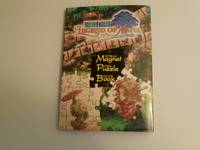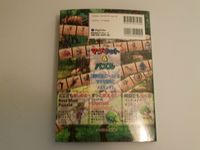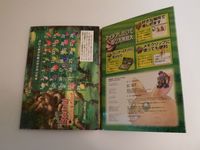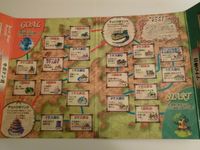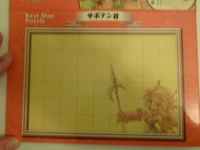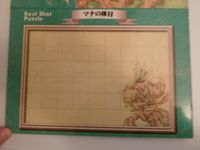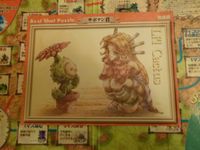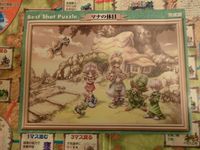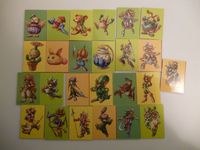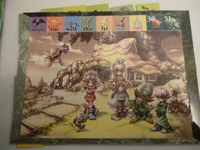Part 97: Posts

Heithinn Grasida talks about the Buddhist themes in Legend of Mana.
Heithinn Grasida posted:
The game doesn't go all out with the Buddhism until the endgame quest, but it's certainly there all the way through. The sproutlings are the main source of the Buddhist stuff until Pohkiel (who the sproutlings have already mentioned as their teacher) starts talking about it at the end.
The major theme of Legend of Mana is a very specific take on Buddhism. I'll explain what the game is trying to say when it comes up later on. Of course, like almost everything in the game, it's not terribly coherent. Furthermore, I can't really say that I'm an expert on Buddhism either, so there might be some things I miss, but the endgame is not subtle about its message, so I'll explain that as best I can when it comes up.
In terms of the Buddhism so far, the sproutlings have already said several things with a religious significance. They've said that the world is an illusion and is created by imagination, that they have no souls and that they all have the same mind. Also they've said that people with pure hearts can go to a whole new world, which is pretty standard fare for any salvational religion.
That the world is an illusion and is created by imagination is a reference to Buddhist doctrine that the objects that populate our world such as tables, chairs, TV sets and beer bottles actually don't exist in and of themselves. Buddhist philosophy is not nihilistic, it's not telling us that nothing exists, but it's heavily empirical. The only things that exist are things that we can directly perceive. Now, when I look at a chair, if I analyze my perception, what am I really seeing? Well, I can see various colors and textures organized into a shape. But that's all that I see. I can only call this collection of loosely related perceptions a chair because I already have the idea that that is what they are. When we perceive the world, what we perceive is a flow of constantly changing colors, lights, sounds and smells. So that's what the world really is. Things like chairs, beer bottles and the town of Domina, that exist by themselves and persist over time, are psychological fictions that we create to be able to interact with the world. In fact, however, they're just illusions created by our imagination.
When the sproutling says that they have no souls, this is probably a mistranslation and it should be rendered as saying they have no self, or no ego. The illusory nature of the self is another major point in Buddhist doctrine and is similar to the illusory nature of external objects. Internal perception, reflection on the contents of our own minds, mirrors external perception. Buddhism still basically takes the empirical approach. We can only have knowledge of what we directly perceive. When I reflect on the contents of my mind, all I perceive is a flow of ever changing thoughts, feelings and perceptions. There is nothing constant within my mind that I can identify as my own self or soul. So the self, or the soul, does not exist. I don't exist and persist through time as a unified being. Again, this is not nihilism, my thoughts and feelings are real and exist. But because I perceive them as ever changing and can find no constant perception of my own self, "I", as a persistent being, don't exist. Both of these doctrines are very similar to the philosophy of David Hume, and I'm probably presenting them from a very Humean angle because that's what I understand better.
The above two points are universal to all schools of Buddhism. That all the sproutlings have the same mind is a reference to Mahayana Buddhism that traditional Indian Buddhism would reject. But I've gone on for far long enough, so I'll save that for another time if there's any interest.
It might seem like I'm really stretching here to connect these random lines to Buddhist philosophy, but as I said, the endgame is very blatant in its Buddhist message and I think it's obvious that the person who wrote this had Buddhism in mind when writing the sproutlings' lines.
Vil goes into some of the mechanics of growing plants.
Vil posted:
Mega64 posted:
As for planting, there's a lot of factors in what you get and how long it takes to grow. There's the type of seeds you use, for instance, as there's several types of seeds. Also, some plants are simply rarer than others. The day you plant and the mana levels of Home also influence types of plants as well as the rate of growth. Some plants will grow more slowly, which can be a pain.
What you get: The seed(s) you use and the random number generator. This is determined at the moment of planting though of course you don't find out the results until they grow enough. There's some fancy bitwise modifications that go on in the process (I've since lost my copy of the explanation though), but the basic upshot is that Seed X + Seed Y will have the possible outcomes of A, B, C, D, ... with various set probabilities.
How fast it grows: What particular plant is trying to grow, Home's mana levels, and what particular days of the week pass. For example, a Rocket Papaya requires (among other things) 16 "points" of Jinn. You get (Home's Jinn level) points every day that passes, and you get 1 extra Jinn point on Jinn day. So with 0 Jinn, you get 1 point per 6-day week (0 points most days, 1 point on Jinn day); with 1 Jinn, you get 7 points per week (1 point most days, 2 points on Jinn day); with 2 Jinn, you get 13 points per week; with 3 Jinn, you get 19 points per week. Most of the elements work similarly, except for Wisp and Shade where you get a freebie point every day. (So the weekly points for those two are 6x + 6 instead of 6x + 1, where x is Home's respective mana level.)
Sparing the math of - and sparing me from digging up - all the points that various produce want, the basic upshot is that you'll want 3 Gnome and at least 1 of everything else. Gnome, even at 3, tends to be the biggest bottleneck (let alone if you have less): so long as you've got 1 of the rest, in the 15 days' time that it takes for the worst-case Gnome requirements to be fulfilled, you'll have fulfilled any other requirements too. You can safely enough skip Shade and leave it at 0, as that boosts the worst-case time from 15 all the way to 16 days for one fruit (Applesocks).
Home and Domina will guarantee you 1 Wisp, 1 Dryad, 2 Aura, 1 Salamander, and 1 Gnome in Home. With the remaining three spots adjacent to Home, you'll only need to add 2 Gnome, 1 Jinn, 1 Undine, and optionally 1 Shade to meet the best-case described above. Anything else is bonus, and may (depending on what exactly is growing) let you harvest sooner than 15 days. (But honestly it takes less time to just walk 7 spaces away and back - don't forget the free day for leaving Home - than it does to walk less distance and go check in early.)
Vil also gets into how placement of Home affects the distance of other lands.
Vil posted:
Serifina posted:
Ah, the Penguin Pirates. They're so ridiculous. But at least they're fun!
One drawback that I noticed, both last time I played and here in the LP, is that the special map setups to let you do everything tend to result in out-leveling the challenge in a hurry, since you can't place lands far enough away to result in higher-level enemies. It's really not a wonder nothing's a threat. (Not that combat in this game is ever all that hard anyway... A common trait in Mana games.)
Most of this is dependent on the cardinality of the land (that is, whatever land you place fifteenth has 15 points counting toward land power and thus enemy levels). Land power, FYI for the thread, is the sum of the land's cardinality and its distance (as the crow flies) from Home. Enemy levels are determined mostly by land power, though they're modified by the land's mana levels and whether the enemy in question is strong or weak to those. (Land power has a few other effects too.)
Still, there is some interesting effect on the distance component of land power depending on a. where you place Home and b. what general land placement pattern you use. It's not a terribly massive effect, mind you, but it's pretty neat:
Location:
A: Home is in a corner.
B: Home is along an edge, 1 space away from a corner.
C: Home is along an edge, 2 spaces away from a corner.
D: Home is 1 space in, in both directions, from a corner.
E: Home is 1 space in from a corner in one direction, and 2 spaces in, in the other direction.
F: Home is 2 spaces in, in both directions, from a corner.
ABCCBA
BDEEDB
CEFFEC
CEFFEC
BDEEDB
ABCCBA
Max Dist: Maximum possible distance an individual land can be from Home. There will only ever be one square that fits the bill.
Min Avg Dist: Average distance from Home of all lands, assuming you try to minimize distance and keep everything as close to Home as possible.
Max Avg Dist: Average distance from Home of all lands, assuming you try to maximize distance and keep everything as far from Home as possible. (Accounts for necessary contiguity.)
Diff: Difference between min and max avg dist, aka how much difference it actually ends up making, whether you try to keep things close to or far from Home.
Location - Max Dist - Min Avg Dist - Max Avg Dist - Diff
-- A -------- 10 -------- 3.85 --------- 5.77 ----- 1.92
-- B --------- 9 -------- 3.31 --------- 5.08 ----- 1.77
-- C --------- 8 -------- 3.08 --------- 4.69 ----- 1.61
-- D --------- 8 -------- 2.77 --------- 4.35 ----- 1.58
-- E --------- 7 -------- 2.54 --------- 3.92 ----- 1.38
-- F --------- 6 -------- 2.38 --------- 3.46 ----- 1.08
The main conclusion I draw from this is that it matters more where you put Home, than it does whether you try to minimize or maximize distance. Also, the more central Home is, the less minimize vs. maximize matters (and the overall lower your distance numbers are, obviously).
Finally, even at the most extreme - minimized location F vs. maximized location A - you're still only looking at an average difference of 3.39 distance. While that's certainly nothing to sneeze at, it's really not a big effect when held up against the land's cardinality (1 to 26), which has more of an impact.
Odd shows off some awesome LoM swag, a magnet puzzle book.
Odd posted:
With permission from Mr. Mega obtained, I'd like to share a piece of swag I bought in a Portland, OR anime store. It's called the "Legend of Mana Magnet Puzzle Book", and it is filled with fun games and puzzles that I have no idea what any of it means because it's all in japanese.
The album link is http://imgur.com/a/1Ih0K.
This is the front cover for the book.
The back cover.
The inside covers. On the left is an "Eternal Calendar", which as far as I know doesn't have any eternal properties. The left is some kind of credits page, maybe an explanation?
The middle 2 inside pages. This is some sort of board game, where you start at HOME and end at a big tree, visiting many of the lands and maybe performing actions at each. I don't know. Maybe A, B, and C are the 3 main plotlines? Looks pretty though!
This is the left inside page. It is a board for doing the "puzzle" part of the book.
The right inside page. Another BEST SHOT PUZZLE board.
A glossy print of one of the BEST SHOT puzzles. This is a separate piece of paper.
The other side of the last picture.
The set of magnets that came with the book. I think I am missing one of them, though. I think the ones on the left are for customizing the "Eternal Calendar", and the ones on the right might be game pieces for the board game? I don't know. These magnets are terrible quality and will not hold a piece of paper to a refridgerator. Pretty, though!
The other side of them. All your favorite characters! BUT NOW THEY ARE MAGNETS.
One side of the actual Best Shot Puzzle. Each piece is also a (bad) magnet can break out and be mixed up for actual Best Shot Puzzle action, but I never did that because I was afraid of losing the pieces, they're a bit smaller than the other magnets. You'll see Frazul and Corona using their JP names up on the top row.
The other side of the Best Shot Puzzle. This one I think looks really cool. Boy Hero lookin all stern over all the riff-raff at his house.
Well, that's everything that came with the "Legend of Mana Magnet Puzzle Book." I have no idea what any of the words say, but it sure is a cool...something. I love it.
